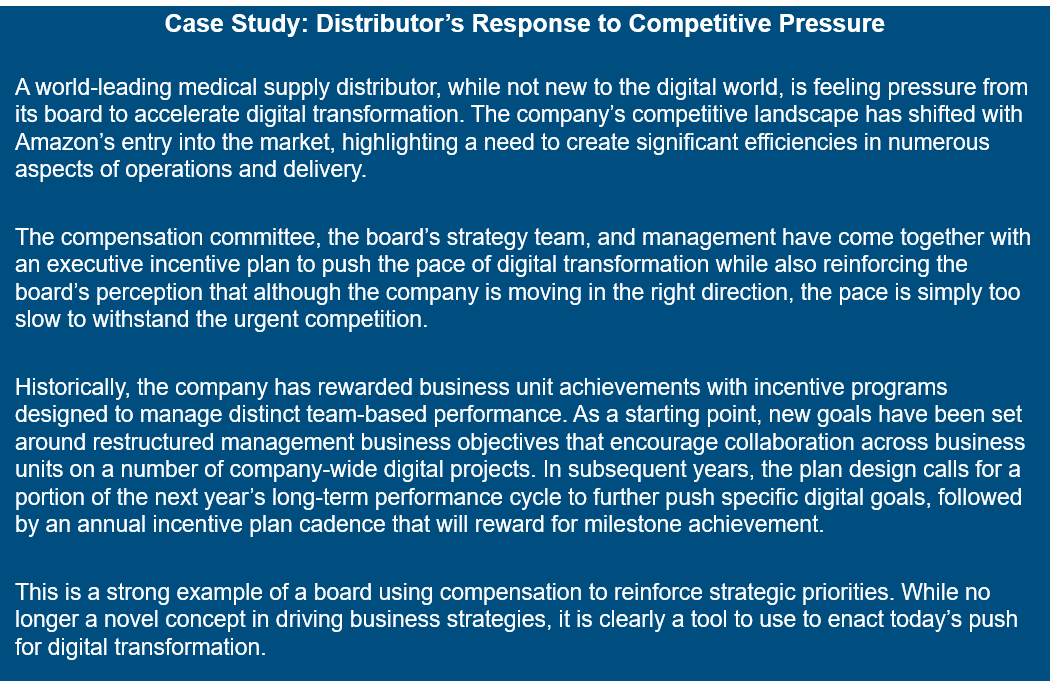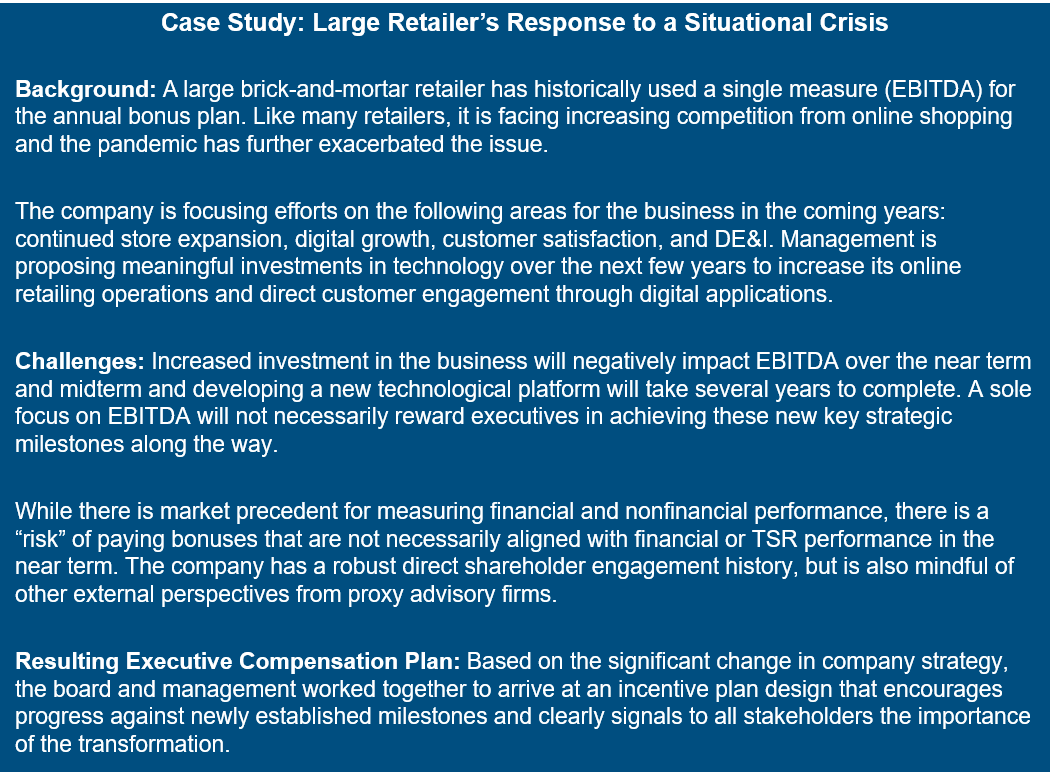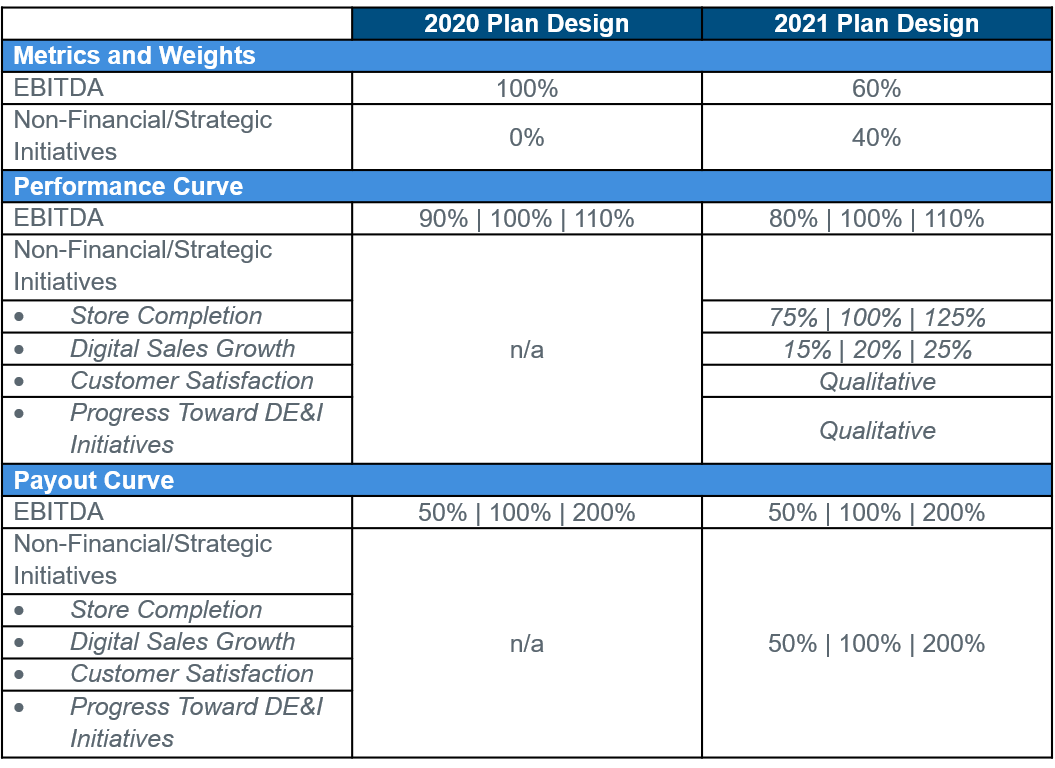
Article | Nov 2021 | NACD Governance Challenges
Incentivizing an Integrated Digital Transformation
How compensation can play a role in driving substantial change.
Introduction
Digital transformation represents many potential positive outcomes for an organization’s efficiency and bottom line. However, it also brings some challenges for corporate culture and the workforce. A good leader has to manage it all. And of course, boards must have a clear understanding of the operational and competitive landscapes and be in active dialog with management—asking the leading questions that can uncover unforeseen risks and opportunities, and developing a well-rounded team with the right CEO as captain.
Today’s reality is that all companies are facing pressure to incorporate a digital framework into their business to a greater or lesser degree. Think about the traditional bell curve. At one end are those who have seen digitization coming and are actively and strategically enacting change, bookended by a similarly sized group that is clinging to their analog world. In the large middle ground are those who are aware but struggling, or putting off the inevitable.
The organizations most well positioned to succeed are not simply externally focused (e.g., “How can we change incentive metrics to incorporate the impact of digital investments and evolving customer expectations?”), nor are they solely looking internally (e.g., “How does digital transformation affect our workforce engagement?”). The big winners are likely to be companies that take a holistic approach to digital—driving an evolving business strategy with strong incentives and combining the efficiencies and productivity gains from available technology with a concern for digital impacts on the workforce and corporate culture. It must all be woven together skillfully by great leaders.
Maintaining an Even Keel: Balancing New Strategic Initiatives While Keeping the Lights On
Digital transformation objectives may bring the realization that short-term profits will be impacted because of the required investment. In other words, a transformation agenda may present a kind of “catch-22” where change is necessary for future success (possibly even survival), but putting plans and budgets in place to ensure the transformation happens will likely result in lower profits for a time.
This near-term difficulty for both boards and management is juxtaposed with the expectation that they are appropriately building for the future. It is not a simple task. For example, a small company may have a significant value-add service or product idea that a behemoth like Amazon simply can’t offer. Yet because it isn’t market-dominating, the small business can’t afford the kind of investment necessary for quick transformation. The practical limitations on digital investment can impact large companies too—investors in mature public companies have expectations regarding annual financial performance, and can react negatively to decreases in profitability without acceptable justification.
Together, the board and management must find a way to balance needed current income with long-term goal-setting and metrics that will ultimately justify a reinvestment of profit that generates bigger returns at a later time. And of course, there are cautionary tales to inaction; recall Eastman Kodak’s unwillingness to lower short-term guidance to the Street in order to enact a strategic pivot.
One way to manage this conundrum may lie in the balanced value drivers concept. By integrating digital transformation objectives into the value driver analysis and the corresponding executive compensation design, boards and management teams can easily and clearly point to the digital transformation strategy they are enacting, how it fits within the larger business strategy, and how the executive compensation plan is aligned in the long term.
Not only does this approach provide a clear roadmap, the simple visual nature of a value driver tree can also anchor strong and compelling conversations with stakeholders, which will be key to investing now for payoff in the future.
We’re All in the Same Boat: The Digital Culture
Digitization isn't just something that happens to our customers, clients, suppliers, and partners—it happens to “us” too. Directors can remind their organizations not to lose sight of how digitization can affect the workforce as a whole, often in fairly dramatic fashion. The latest work-from-home, work-from-anywhere shift is a glaring example.
There are other significant cultural changes that can take place. For example, an “always on” expectation arising from tools like Zoom and Slack can have positive short-term influence on productivity and goal-setting, but over the long term may negatively affect employee engagement and lead to burnout or even retention issues. Management dynamics may change when previously “high-touch” activities such as performance reviews become automated through HRIS systems. Compensation can also be impacted by these changes in myriad ways: questions about geographic differentials in base pay and the need for recruiting and retention bonuses to maintain staffing levels and leadership teams are two current issues.
While there may be no avoiding difficult change, awareness and empathetic leadership may help many organizations manage the inevitable bumps.
Who’s at the Helm? Board Leadership and Management Team Development
The ultimate success of a strategically planned digital transformation may come down to one simple factor: Do we have the requisite skillset to deliver on the digital strategy?
Having a strategic plan champion on the board can be a huge indicator of success. Absent that one strong voice, a well coordinated board that is dedicated to the ongoing development of the management team’s leadership can help drive and support major business changes.
Boards that are focused on developing leaders of the future are looking for the same skills and attributes that a digital initiative requires: a continuously learning mindset, innovative thinking, resiliency, courage, and an openness to diversity of thinking. Further, directors who are coordinated in helping maximize the effectiveness of the leadership team are also concerned with maintaining institutional knowledge through a deep talent pipeline and avoiding churn and turnover where possible. They are cognizant of how executive compensation and rewards programs can support the building of great management teams, and how specific, strategic goal-setting can set up achievement of short-term milestones on the way to long-term business success.
Conclusion
As any director or senior leader involved in a significant business evolution or turnaround will attest, the early stages of transformational change require constant dialogue amongst and between the board and management. Frequently asking (more often than just quarterly) “What have we changed to reinforce this shift and what kind of progress are we making?” is key.
Given the usual expectations of a board, there may be a tendency to pull back and focus only on the big picture. While a holistic view of how the transformation is taking shape and its impact on the business are important, this may be a time when more micro versus macro attention is warranted. Directors shouldn’t necessarily look for immediate tangible results, but take a milestones approach and focus on the steps being taken. Encourage management to frequently communicate these milestones both internally across business units that may be working more closely together than is typical and with external stakeholders, particularly investors and their advisors.
Finally, use the compensation plan design as a change agent. Annual reviews should scan for any confusing and/or conflicting signals as to priorities and for any unintended consequences taking shape. Assess where progress is being made, where additional emphasis is needed to achieve the long-term vision, and set goals and targets accordingly.


